TL;DR Summery: A moody living room uses dark, rich colors like charcoal, navy, and forest green paired with layered lighting and plush textures to create an intimate, sophisticated space. This design style works exceptionally well in rentals through removable wallpaper, strategic paint choices, and furniture-focused transformations that require no permanent changes.
How to Create a Moody Living Room
Scrolling through endless beige living rooms feeling uninspired by the lack of a moody living room aesthetic? You’re not alone. Many assume they’re stuck with bland, neutral spaces that lack personality and warmth. The truth is, creating a dramatic, sophisticated, moody living room doesn’t require owning your space or making permanent changes.
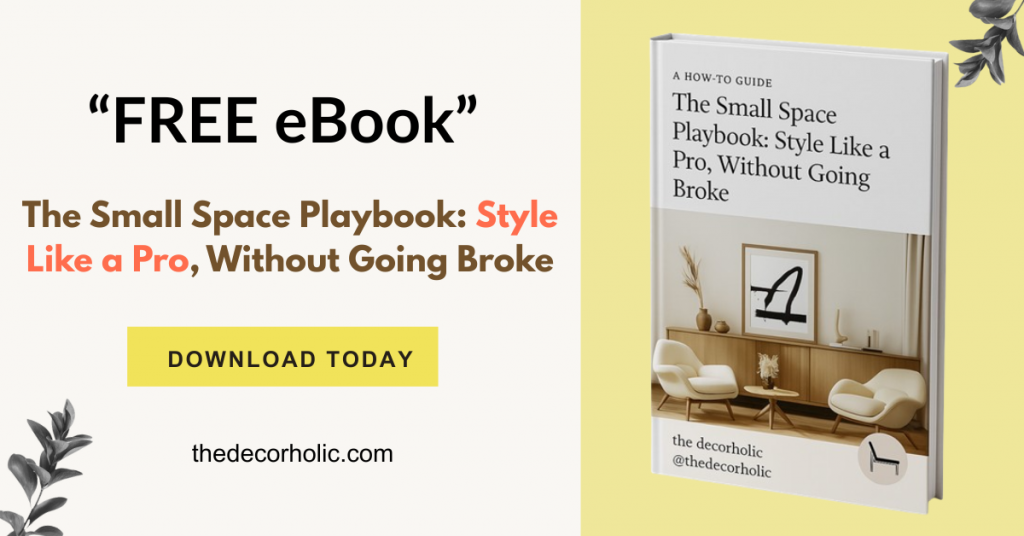
A moody living room embraces rich, dark colors and atmospheric lighting to transform ordinary spaces into cozy sanctuaries that feel both luxurious and deeply personal. Whether you’re working with a cramped apartment or a spacious rental, this design approach offers the perfect blend of drama and functionality.
This guide reveals exactly how to design a moody living room that works within rental restrictions while delivering the sophisticated, intimate atmosphere you crave.
I. What Is a Moody Living Room?
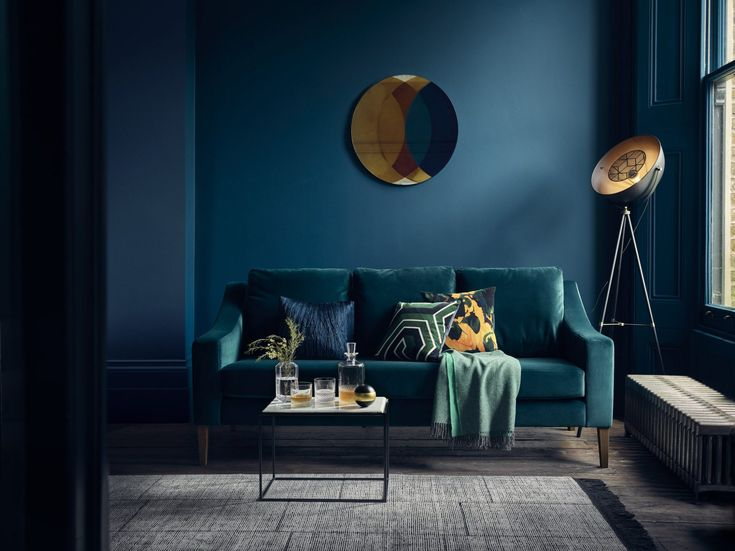
A moody living room is characterized by dark, saturated color palettes (typically charcoal, navy, emerald, or deep burgundy), layered lighting that creates shadows and depth, and rich textures like velvet and leather that add tactile warmth to dramatic spaces. This design style prioritizes atmosphere over brightness, creating intimate environments that feel cocooning rather than expansive.
The moody aesthetic emerged as a counter-movement to the bright, minimalist Scandinavian style that dominated for years. Design trends for 2026 show a continued embrace of deeper, more muted colors including plums, greens, and sophisticated dark grays. Unlike stark minimalism, moody spaces layer textures, incorporate vintage elements, and celebrate visual complexity.
This style works particularly well in rentals because it focuses on transformation through furniture, lighting, and decor rather than architectural changes. The key is understanding that “moody” doesn’t mean dark and depressing—it means intentionally curated, atmospheric, and deeply comfortable.
Expert Tip: Layer at least three different light sources at varying heights to prevent dark spaces from feeling cave-like. Combine floor lamps, table lamps, and wall sconces to create dimensional lighting that enhances rather than fights your dark palette.
Don’t Miss: 9 Small Powder Room Genius Hacks
II. Why Choose a Moody Living Room Design?

Moody living rooms create psychological comfort through their cocooning effect, making spaces feel more intimate and relaxing while hiding imperfections especially common in rental properties. Research shows that darker colors can actually make rooms feel more sophisticated and valuable—Zillow found that homes with dark gray living rooms sold for $2,593 more on average.
Beyond the numbers, there are compelling practical reasons to embrace this style:
- Hides rental flaws: Dark walls and moody lighting disguise scuffed baseboards, outdated fixtures, and wall imperfections that bright white spaces highlight
- Defines ambiguous spaces: Small apartments often lack architectural definition; dark colors create visual boundaries and purpose
- Timeless sophistication: Unlike trendy pastels or loud patterns, moody palettes remain stylish across design cycles
- Enhances relaxation: Deep colors trigger feelings of calm and security, perfect for unwinding after work
- Showcases artwork and decor: Dark backgrounds make colorful art, metallic accents, and decorative objects pop dramatically
The cocooning effect is particularly valuable for renters in bustling urban areas or shared housing situations. Creating a dark, intimate retreat provides psychological separation from the chaos outside your four walls.
Expert Tip: Dark colors are your best friend for hiding television screens and electronics. A charcoal or navy wall makes flat-screen TVs virtually disappear when turned off, eliminating the “black rectangle” problem that plagues bright spaces.
Don’t Miss: The Complete Guide to Candle Holders: Transform Your Interior Design
III. How to Choose the Perfect Color Palette for Your Moody Living Room
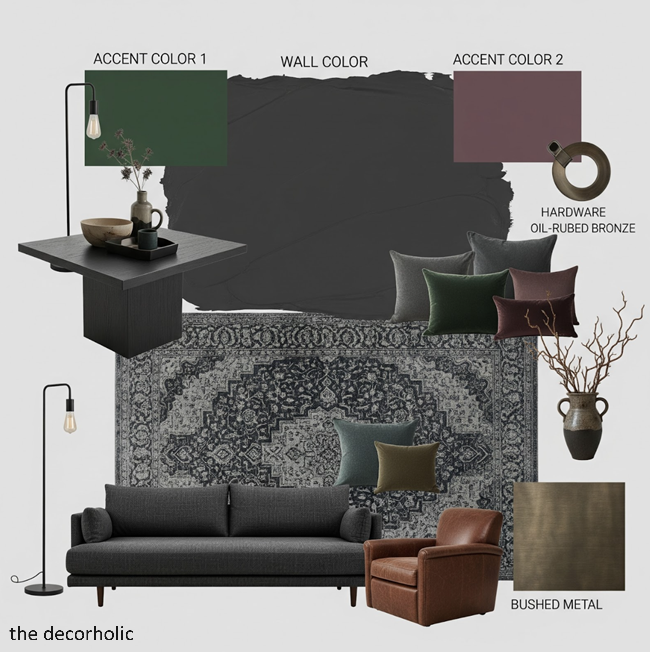
The foundation of a successful moody living room starts with selecting one dominant dark color (navy, charcoal, forest green, or deep burgundy) and pairing it with 2-3 lighter accent shades in the same tonal family to prevent the space from feeling flat or monotonous.
Your color strategy should account for your rental’s existing elements and how light interacts with your space throughout the day. Understanding color theory basics helps you avoid the common pitfall of choosing a dark color that looks stunning on a paint chip but reads entirely different on your actual walls. The relationship between your primary dark shade and supporting colors determines whether your room feels sophisticated or simply gloomy.
Selecting Your Base Color
Your base color sets the entire mood and must work harmoniously with elements you cannot change as a renter. The wrong choice here creates frustration and wasted money, while the right selection makes every subsequent design decision easier and more cohesive.
Consider these factors when choosing your primary dark shade:
- Natural light exposure: North-facing rooms can handle charcoal and navy; south-facing spaces with abundant light look stunning in deep burgundy or forest green
- Existing fixtures: If your rental has warm-toned wood floors, choose colors with warm undertones (deep brown-grays, burgundy); cool-toned fixtures pair better with blue-grays and navy
- Room size: Contrary to popular belief, small rooms can absolutely handle dark colors—they just need the right lighting strategy
- Personal preference: You’ll be living here; choose colors that genuinely resonate with you
Creating Depth with Accent Colors
A monochromatic dark room feels one-dimensional and oppressive. Accent colors provide visual relief points where your eye can rest, creating rhythm and preventing the space from feeling relentlessly heavy. Think of accent colors as the punctuation in a sentence—they give structure and breathing room to your primary color statement.
Moody doesn’t mean monochromatic. Layer in these complementary shades:
- Warm metals: Brass, gold, and copper create warmth against cool darks
- Soft neutrals: Cream, warm white, and light gray prevent visual heaviness
- Jewel tones: Emerald, sapphire, or ruby as small accents add richness
- Natural wood tones: Warm walnut or oak grounds the palette organically
The most sophisticated moody living rooms use the 60-30-10 rule: 60% dominant dark color, 30% medium tone (often through furniture), and 10% accent color (in pillows, art, and accessories).
Expert Tip: Choose paint colors with an LRV (Light Reflectance Value) between 5-15 for true moody depth. Anything above 20 reads as mid-tone rather than dramatic dark. Benjamin Moore’s “Hale Navy” (LRV 8) and Sherwin Williams’ “Iron Ore” (LRV 6) are excellent starting points.
Trending Post: Pastel Wall Colors – Your Guide to Serene, Stylish Spaces
IV. Renter-Friendly Ways to Add Dark Color Without Painting

For renters unable to paint, removable peel-and-stick wallpaper, large-scale dark furniture, and floor-to-ceiling curtains create moody atmosphere without permanent changes or security deposit risks. These approaches let you achieve the dramatic effect while maintaining flexibility and protecting your deposit.
Many landlords prohibit painting or charge exorbitant fees for repainting upon move-out. This shouldn’t stop you from creating your moody sanctuary. Modern products and strategic design choices deliver the same visual impact without touching a paintbrush to the walls. The key is thinking beyond traditional wall color and recognizing that darkness can be introduced through multiple layers.
Removable Wallpaper Solutions
Modern peel-and-stick wallpaper has revolutionized renter design. Unlike the permanent wallpaper of previous generations, today’s removable options adhere strongly during use but peel away cleanly without damaging paint or leaving residue. Quality matters enormously here—cheap versions can leave marks or tear during removal, while premium products come off smoothly even after years of use.
The texture and pattern options now rival traditional wallpaper, from realistic dark wood planks to moody botanical prints to sophisticated geometric patterns. Application is straightforward enough for DIY installation, though precision matters for pattern-matching.
- Accent wall application: Cover one full wall in deep charcoal, navy botanical prints, or dark geometric patterns
- Ceiling treatment: Dark ceilings lower visual height and add unexpected drama (yes, removable wallpaper works on ceilings too)
- Behind shelving: Create depth by wallpapering the wall behind floating shelves or bookcases
Look for products specifically labeled “renter-friendly” or “temporary wallpaper” from brands like Tempaper, Spoonflower, or WallsNeedLove. These remove cleanly without damaging paint or drywall.
Furniture-First Approach
Your largest furniture pieces occupy significant visual real estate. A standard three-seat sofa typically covers 80-100 square feet of visual space when you account for its bulk and presence. That’s more surface area than many accent walls. By selecting furniture in your desired dark palette, you create the moody foundation without ever altering the rental’s permanent features.
This strategy offers obvious practical advantages—your investment is portable and builds your long-term furniture collection rather than improving someone else’s property. The impact is immediate and substantial, fundamentally shifting the room’s entire character.
Let large furniture pieces carry your dark palette:
- Oversized sectionals: A charcoal or navy sectional immediately shifts the entire room’s mood
- Statement media console: A deep wood or painted cabinet grounds entertainment areas
- Dark accent chairs: Velvet or leather chairs in rich colors create focal points
The advantage here is obvious: when you move, your investment moves with you.
Textile Transformations
Fabric is the most flexible way to introduce darkness into rental spaces. Blackout curtains, rugs, and throws can be installed and removed in minutes, yet their visual impact rivals permanent architectural changes. Heavy, dark textiles also improve acoustics by absorbing sound—a valuable benefit in apartments with thin walls or hard surfaces that echo.
The layering approach works particularly well: start with dark curtains to frame windows dramatically, add a substantial dark rug to anchor your seating area, then layer in throw blankets and pillows to reinforce the palette. Each textile adds another dimension of darkness without overwhelming the space.
Fabric creates instant atmosphere:
- Floor-to-ceiling curtains: Dark velvet or heavy linen drapes frame windows dramatically and improve sound dampening
- Large area rugs: Deep-toned rugs (at least 8’x10′) anchor seating areas and add warmth underfoot
- Layered throw blankets: Drape dark textured throws over sofas and chairs for instant coziness
Expert Tip: When using dark removable wallpaper, apply it to the wall opposite your main window first. This lets incoming light highlight the texture and pattern, creating dramatic shadows throughout the day that enhance the moody effect rather than making the room feel closed-in.
Don’t Miss: How to Decorate Blank Walls for Renters
V. Lighting Strategy: The Secret to Making Dark Rooms Work

Lighting is the non-negotiable element that determines whether your moody living room succeeds or fails spectacularly. You can have perfect color choices, beautiful furniture, and ideal proportions, but inadequate lighting transforms sophisticated into suffocating.
Dark walls absorb 60-80% of light versus light walls that reflect 70-80%, which means your moody living room literally needs 2-3 times more light sources than an equivalent light-colored space to achieve comfortable visibility.
The Three-Layer Lighting System
Professional designers never rely on a single lighting source because flat, even illumination destroys atmosphere and dimension. The three-layer approach creates complexity, shadows, and visual interest while ensuring adequate light for all activities.
How to implement three-layer lighting:
- Ambient lighting: Replace overhead fixture bulbs with warm white LEDs (2700K-3000K) for baseline illumination
- Task lighting: Position adjustable reading lamps near seating areas and work spaces for focused activities
- Accent lighting: Add uplighting in corners, LED strips behind furniture, and picture lights on artwork
- Use arc floor lamps to provide overhead-style lighting without requiring hardwiring or landlord permission
- Install plug-in dimmers on portable lamps for mood control throughout the day
Strategic Placement Guidelines
The positioning of your light sources matters as much as the quantity. Dark corners absorb light and create visual weight that makes rooms feel smaller and heavier—every corner needs its own light source to counteract this effect and “lift” the space visually.
How to position lighting for maximum impact:
- Place a floor lamp or table lamp in each corner of the room to eliminate dark dead zones
- Position lamps near mirrors or metallic surfaces to multiply light impact through reflection
- Distribute light sources throughout the room rather than relying on center-only overhead lighting
- Create a “lighting map” by sketching your layout and marking where you need light for specific activities
- Aim for minimum five total light sources (one overhead, two floor lamps, two table lamps)
Bulb Selection Matters
Not all light bulbs are created equal, and choosing the wrong temperature or quality ruins your entire color scheme. Low numbers (2700K-3000K) produce warm, yellowish light similar to candlelight, while high numbers (5000K+) create bluish, clinical light that makes dark spaces feel cold rather than cozy.
How to choose the right bulbs:
- Select LED bulbs rated 2700K-3000K for warm white light that complements moody palettes
- Avoid bulbs above 3500K which cast bluish tones that fight against your color scheme
- Choose bulbs with high CRI (Color Rendering Index) ratings above 90 for accurate color display
- Replace every single bulb with matching temperature for consistency
- Keep extra bulbs on hand so you can replace burned-out bulbs immediately
Expert Tip: Install smart bulbs in your rental’s existing fixtures and your portable lamps. This allows you to program different “scenes” for various times of day—brighter task lighting for mornings and work hours, warm ambient lighting for evenings—all controlled from your phone without any permanent electrical modifications.
Also: The Best Wall Sconces to Transform Your Space
VI. Furniture Selection and Arrangement for Moody Spaces

Your furniture choices either support or sabotage your moody vision completely. Delicate glass coffee tables and spindly mid-century chairs might look sophisticated in bright, airy rooms, but they disappear against dark walls and create jarring disconnect between your color palette and furnishings.
Moody spaces demand pieces with presence—furniture that feels grounded, substantial, and proportionally matched to your dramatic walls.
Sofa and Seating Selection
Your sofa is the largest single piece in most living rooms, dominating the visual landscape and setting the tone for all other furniture choices. In moody spaces, the sofa must anchor rather than fade into the background through substantial depth, rich upholstery, and visual weight.
How to choose the perfect moody sofa:
- Prioritize deep-seated sofas (38-42″ seat depth) that encourage lounging and feel proportionally correct
- Choose rich textures like velvet, leather, or heavyweight linen in charcoal, navy, forest green, or cognac brown
- Consider low-profile designs (under 35″ back height) in small spaces to maintain visual openness
- Add layered seating by pairing your main sofa with accent chairs in complementary dark or jewel tones
- Avoid bright white, pale gray, or light beige upholstery which creates jarring contrast
Coffee Tables and Surfaces
Dark rooms need reflective surfaces to bounce light around and prevent visual flatness. Your coffee table serves both functional and aesthetic purposes—anchoring your seating arrangement while providing crucial light reflection at eye level when seated.
How to select coffee tables for moody rooms:
- Choose glass tops with dark metal bases to maintain visual openness while reflecting light
- Select polished wood in rich walnut or mahogany that reflects light while adding warmth
- Consider marble or stone in black, deep green, or charcoal for natural pattern and luxurious weight
- Scale appropriately—coffee tables should be at least 1/2 to 2/3 the length of your sofa
- Add metallic side tables or nesting tables in brass, copper, or antiqued gold
Storage and Media Solutions
Rentals notoriously lack adequate storage, and visible clutter destroys moody sophistication faster than any other single element. The curated, intentional aesthetic essential to moody design requires ruthless organization and concealment of everyday chaos.
How to manage storage in moody living rooms:
- Choose dark media consoles and cabinets with closed storage to hide electronics and clutter
- Install temporary command-strip floating shelves in dark wood or black metal
- Display only carefully curated objects—a few meaningful books, one beautiful plant, a sculptural piece
- Use ottomans with hidden storage, dark baskets under consoles, and decorative boxes
- Maintain the “every visible object should be intentional and beautiful” standard
Expert Tip: Measure your doorways before ordering furniture. Many sophisticated moody pieces (deep leather sofas, substantial media cabinets) exceed standard 32″ doorway widths. Check if legs, arms, or backs are removable, or you’ll face a costly return situation when your dream piece won’t fit through the door.
Trending Post: How to Decorate Your Side Table for Style and Function
VII. Texture and Textiles: Adding Warmth to Dark Spaces

In bright white rooms, you can skip texture and still maintain visual interest through color variation and light play. In moody spaces, texture becomes absolutely essential because your color palette is deliberately limited. Without varied textures, dark rooms read as flat and lifeless—beautiful in photographs but uncomfortable in person. Texture creates the subtle variations in light reflection and shadow that bring depth and life to dark surfaces.
Essential Texture Layers
Every surface in your moody living room offers an opportunity for textural interest, and strategic layering of different materials creates visual complexity that prevents the monotonous feeling dark colors can produce when handled incorrectly.
How to layer textures on your sofa:
- Start with base upholstery in velvet, performance velvet, or leather
- Drape linen or chunky knit throw blankets casually over arms and backs
- Mix pillow textures including velvet, faux fur, boucle, leather, and linen
- Vary pillow sizes (22″, 20″, and 18″ squares) to create depth
- Combine at least three different textures in your pillow mix
How to add texture on floors:
- Layer rugs for maximum impact: jute or sisal base rug with smaller patterned rug on top
- Choose high-pile textures like shag, wool, or plush in dark neutrals
- Ensure rugs are large enough that at least the front legs of all furniture rest on the rug
- Consider vintage or overdyed rugs that add pattern without introducing too much color
- Use rug pads to prevent slipping and add cushioning underfoot
How to incorporate texture on walls and windows:
- Hang heavy curtains in velvet, heavyweight linen, or textured weaves
- Add woven wall hangings, macramé pieces, or textile art for three-dimensional interest
- Position natural elements like dried pampas grass or branches in substantial floor vases
- Install textured removable wallpaper rather than flat solid colors when possible
- Layer window treatments with sheer panels behind heavy curtains for light control options
How to create textural variety on surfaces:
- Combine ceramic, wood, and metal objects on coffee tables and shelves
- Stack books with varied spine textures and colors
- Include natural objects like stones, shells, or driftwood
- Mix smooth and rough surfaces in every vignette
- Apply the “rule of three textures” to every grouping
Expert Tip: Introduce at least one unexpected texture that contrasts with your overall palette. A chunky undyed wool throw in cream against a charcoal sofa, or a smooth brass object on a rustic wood surface creates the “aha” moments that make moody rooms feel professionally designed rather than one-note.
Also: The Ultimate Guide to Designing the Perfect Vignette for Your Home
VIII. Wall Decor and Art for Moody Living Rooms
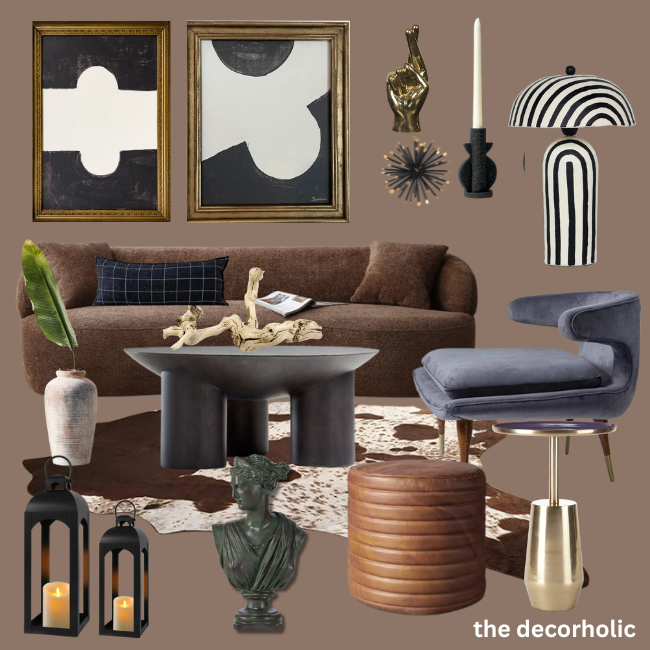
Your carefully chosen dark palette creates the perfect dramatic backdrop for showcasing wall art and decorative objects, but it also creates unique challenges. What works beautifully against white walls often disappears against charcoal or navy, requiring you to think differently about scale, contrast, and framing.
Art Selection Strategies
The relationship between art and wall color is fundamentally different in moody spaces than in light rooms. Against white walls, almost any artwork creates contrast and draws the eye. Against dark walls, only high-contrast or properly lit pieces achieve visual impact.
How to select art for dark walls:
- Scale dramatically—choose single oversized pieces (40″x60″ or larger) rather than multiple small pieces
- Frame large-format photography or museum posters if you can’t afford original large-scale art
- Create your own abstract art using canvas and paint in your accent colors
- Choose high-contrast subjects: black and white photography, colorful abstract work, or light-colored subjects
- Ensure artwork has significant tonal contrast with your wall color for visibility
How to frame art for moody spaces:
- Use white or cream mats to create breathing room between artwork and dark walls
- Choose gold or brass frames that add warmth and catch light beautifully
- Select black or charcoal frames for seamless, modern gallery-wall effects
- Maintain consistent frame profiles within each gallery wall or room
- Invest in quality framing—it makes affordable art look expensive
Gallery Wall Guidelines
Gallery walls offer a solution when budget or preference favors multiple smaller pieces over single large-scale art. However, gallery walls in moody spaces require more careful planning than in light rooms because the relationship between frames, spacing, and background becomes critical.
How to create successful gallery walls on dark walls:
- Maintain consistent framing (all black, all gold, or all white frames with similar profiles)
- Plan your layout by tracing frames on kraft paper and arranging on the floor first
- Keep spacing tight (2-3″ between frames) to prevent the “floating” look
- Center the middle of your arrangement at 57-60″ from the floor for proper viewing height
- Create balance through varied frame sizes while maintaining consistent style
Three-Dimensional Wall Elements
Flat art isn’t your only option for creating visual interest on dark walls. Three-dimensional elements introduce actual shadow play that changes throughout the day as light moves, adding living, dynamic quality to your design.
How to add dimension beyond flat art:
- Install floating shelves to display curated books, plants, and sculptural objects
- Add wall sconces that provide functional lighting while serving as architectural jewelry
- Hang oversized mirrors with interesting frames to reflect light and expand space perception
- Position metal, wood, or ceramic wall sculptures that create dramatic shadows
- Light your artwork with battery-operated picture lights or strategically aimed spotlights
Expert Tip: Light your artwork properly. Battery-operated picture lights or strategically aimed spotlights transform good art into gallery-worthy focal points. The interplay of illuminated art against dark walls is one of the signature moves of professional moody design—it’s how museums display work in dimly lit galleries.
Also: How To Create a Dining Room Gallery Wall
IX. Incorporating Natural Elements and Plants

Natural elements prevent moody spaces from feeling too designed or artificial by introducing organic imperfection, movement, and life that balances the deliberate, controlled nature of moody design.
The vibrant greens of living foliage pop dramatically against charcoal, navy, or burgundy walls in ways they never could against white or beige backgrounds.
Plant Selection for Low Light
Many rentals lack ideal natural light, and heavy curtains essential to moody aesthetics further reduce available light. Fortunately, numerous plant species thrive in lower light conditions, making them perfect companions for moody living rooms.
How to choose plants for moody spaces:
- Select large floor plants like snake plants, pothos, ZZ plants, or Chinese evergreens that tolerate low light
- Choose tabletop plants including peace lilies, philodendrons, or dracaenas for varied heights
- Consider dramatic statement plants like fiddle leaf figs, monstera, or bird of paradise if you have moderate light
- Use substantial planters in oversized ceramic, concrete, or woven baskets that feel proportional to dark walls
- Be realistic about your care capabilities—dead plants destroy moody sophistication instantly
Styling Plants in Moody Spaces
How you display plants matters as much as which plants you choose. Thoughtful styling integrates greenery seamlessly into your design rather than treating plants as separate decorative afterthoughts.
How to style plants effectively:
- Cluster 3-5 plants together at varying heights rather than spacing them evenly around the room
- Position plants where they benefit from both natural window light and lamp light
- Choose planters in neutral tones or black that complement rather than compete with your palette
- Position large plants in front of windows for stunning backlit silhouettes against dark walls
- Group plants with complementary shapes—upright specimens with trailing varieties
Other Natural Elements
Beyond living plants, incorporate natural materials and elements that echo organic forms and bring warmth to dark spaces without requiring watering or maintenance.
How to add natural elements beyond plants:
- Include natural wood bowls, trays, and side tables in warm wood tones
- Display stone and ceramic vases, sculptures, or decorative objects with organic textures
- Position dried pampas grass, eucalyptus branches, or dried flowers in substantial floor vases
- Incorporate woven materials through baskets, wall hangings, or jute rugs
- Mix natural textures with your other design elements rather than segregating them in one area
Expert Tip: Position large plants in front of windows rather than beside them. This might seem counterintuitive, but it creates stunning backlit silhouettes while still allowing the plant adequate light. The dramatic shadowy outline against your dark walls elevates the entire space from merely dark to intentionally atmospheric.
Also: Faux Plants Secrets to Decorate Like a Pro (And Fool Everyone!)
V. Common Moody Living Room Mistakes to Avoid
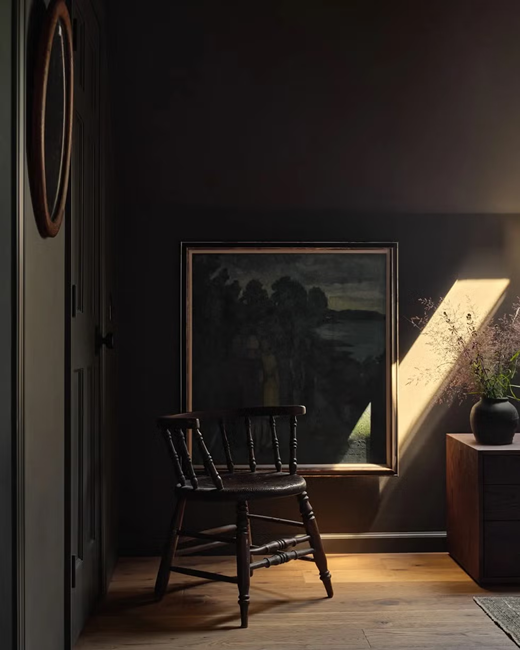
The most common failures in moody living room design stem from insufficient lighting, monochromatic color schemes without tonal variation, and neglecting texture layers—all of which create oppressive rather than atmospheric spaces. Avoiding these pitfalls separates amateur attempts from professionally executed moody design.
Understanding what doesn’t work is often more valuable than knowing what does. These mistakes are predictable, common, and completely avoidable once you recognize the underlying issues. Learn from the errors others have made so you don’t waste time, money, and emotional energy on approaches that inevitably fail.
Mistake #1: Not Enough Light Sources
The problem: Relying on a single overhead fixture or too few lamps leaves dark rooms unusable after sunset and creates a depressing cave-like atmosphere that makes you want to avoid the space rather than relax in it.
This is the number one reason moody living rooms fail. People underestimate how much light absorption occurs with dark surfaces and don’t compensate adequately. What feels like sufficient lighting against white walls becomes dramatically insufficient against charcoal or navy.
The solution: Implement the three-layer lighting system with minimum five total light sources distributed throughout the room—overhead fixture, two floor lamps, two table lamps. Your dark walls absorb more light than you expect—overcompensate with lighting and use dimmers if it feels too bright during the day.
Mistake #2: All Dark Everything
The problem: Painting every wall, ceiling, trim, and door the same dark color creates a flat, cave-like effect with no visual relief or dimensional interest. The eye needs contrast and variation to perceive depth and space.
While committing fully to dark colors feels bold and dramatic in theory, unrelieved darkness becomes oppressive quickly. Even the most successful moody spaces incorporate strategic relief through lighter elements that give the eye places to rest.
The solution: Maintain some contrast—keep trim in white or cream, consider one lighter accent wall, or ensure your ceiling is at least two shades lighter than your walls. Strategic contrast creates depth and prevents the closed-in feeling. Even moody spaces need breathing room and visual hierarchy.
Mistake #3: Wrong Undertones
The problem: Mixing warm and cool undertones creates muddy, confused color schemes that never look quite right no matter how much you adjust. The colors fight each other rather than harmonizing, creating visual tension that feels uncomfortable even if you can’t articulate why.
This subtle error undermines otherwise good design. A charcoal with blue undertones paired with warm cognac leather and brassy gold accents will always feel slightly off because the temperature conflict prevents visual cohesion.
The solution: Stick to one temperature family throughout your space. If your dark walls have warm undertones (brown-based grays, burgundy, warm charcoal), choose warm metals (brass, copper, gold), warm-toned woods, and accent colors with similar warmth. Cool-toned walls (blue-grays, true navy, cool charcoal) need silver metals, cool-toned woods like ash or weathered oak, and coordinating cool accents.
Mistake #4: Ignoring Scale
The problem: Small furniture and delicate decor look lost and out of place against dramatic dark walls. The visual weight imbalance makes the room feel awkward—either the walls overwhelm the furniture, or the space feels empty despite being furnished.
What looks appropriately scaled against light walls needs to increase in size and substance against dark backgrounds. The furniture that worked in your previous bright apartment will likely feel insubstantial in your moody living room.
The solution: Size up everything—larger furniture, oversized art (minimum 40″x60″ for wall art), substantial decorative objects. Dark rooms need visual weight to feel balanced and intentional. When shopping, choose pieces that feel almost too large; they’ll read as appropriately scaled against your dark walls.
Mistake #5: Sacrificing Function for Aesthetics
The problem: Creating a beautiful dark space that’s impractical for daily living—you can’t see to read comfortably, have difficulty finding items, or feel claustrophobic after spending time in the space. Beauty without functionality leads to spaces you admire but don’t actually enjoy using.
Moody design requires balancing atmosphere with livability. If your room looks magazine-perfect but you avoid spending time there, the design has failed regardless of aesthetic success.
The solution: Test your design by actually living in the space for at least a week. Can you comfortably read in every seating area? Can you see well enough for daily tasks? Does the room feel welcoming when you come home, or do you turn on every light immediately? Make adjustments based on real use patterns rather than theoretical design principles.
Mistake #6: Neglecting Window Treatments
The problem: Bare windows or builder-grade blinds break the moody illusion and allow harsh, uncontrolled light to fight your carefully planned atmosphere. Windows become bright rectangles that draw the eye and undermine your color palette during daytime hours.
Window treatments are often treated as optional finishing touches, but in moody rooms they’re structural elements as essential as your wall color. They control light quality, add texture, frame views, and complete the enveloping atmosphere.
The solution: Invest in proper curtains as one of your first priorities. Floor-to-ceiling panels in heavy fabric (velvet, heavyweight linen, or textured weaves) control light quality and frame windows dramatically. This is one of the highest-impact upgrades you can make—the transformation is immediate and substantial.
Expert Tip: If your moody living room still feels “off” after implementation, the issue is likely your lighting temperature. Replace every single bulb with matching 2700K warm white LEDs and see if the space transforms. Inconsistent lighting temperatures (mixing daylight, soft white, and warm white bulbs) sabotages color harmony and makes even well-designed spaces feel wrong.
Don’t Miss: 15 Professional Decor Styling Tricks to Transform Your Home Like an Interior Designer
XI. Budget-Friendly Moody Living Room Ideas for Renters
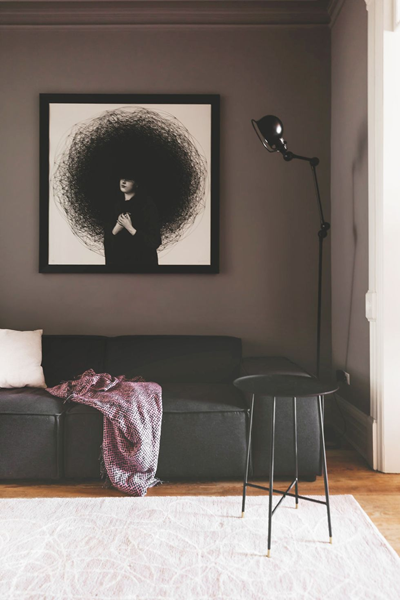
Creating a moody living room on a budget prioritizes high-impact changes like removable wallpaper on one accent wall, secondhand dark furniture, and DIY textile projects over expensive renovations, allowing renters to achieve dramatic transformation for under $1,000. Strategic spending on key elements yields professional results without premium prices.
The assumption that moody design requires expensive materials and professional help prevents many renters from attempting this style. In reality, moody aesthetics are remarkably budget-friendly because they emphasize atmosphere and curation over quantity. A few well-chosen dark pieces create more impact than filling a bright space with numerous lighter items.
Secondhand markets offer particular advantages for moody design. Vintage and antique furniture often features the rich wood tones, substantial construction, and quality materials perfect for moody spaces. Pieces that look dated or heavy in bright, modern contexts find new life against dark walls where their character becomes an asset rather than a liability.
Priority Spending Hierarchy
Strategic budget allocation ensures you create maximum impact with limited funds. Not all elements carry equal visual weight—focusing spending on high-impact areas while economizing on supporting elements produces professional results without professional budgets.
Tier 1: Highest Impact ($300-500)
These foundational elements establish your moody aesthetic and should receive the bulk of your budget. Compromising on these core pieces undermines your entire design, while investing here creates immediate, dramatic transformation.
- One wall of quality removable wallpaper in dark color/pattern (approximately $150-200 for 8’x10′ wall)
- New sofa or reupholstering existing sofa in dark fabric ($300-500 secondhand or Ikea; $200-300 for professional reupholstering)
- Large area rug (8’x10′ minimum) in dark or moody tones ($150-300 from discount retailers or secondhand)
Tier 2: Supporting Elements ($200-300)
Once your foundation is established, these elements add necessary functionality and atmosphere. They’re essential for making the space livable and comfortable, but offer more flexibility for budget shopping.
- Three quality lamps with warm LED bulbs: floor lamp plus two table lamps ($80-150 total from Target, HomeGoods, or secondhand)
- Curtain panels floor-to-ceiling ($60-100 from Target, IKEA, or Amazon—prioritize length over fabric quality)
- Throw pillows in various textures: 6-8 pillows ($60-80 from HomeGoods, TJ Maxx, or Amazon)
Tier 3: Finishing Touches ($100-200)
These details complete the look and add personality but can be accumulated gradually over time. Start with one or two items from this category and build your collection as budget allows.
- Plants and planters: start with 2-3 large plants ($40-60 for plants and containers)
- Throw blankets: 2-3 in complementary textures ($30-60 from discount retailers)
- Coffee table books, decorative objects, and small accessories ($30-80 thrifted or from HomeGoods)
Money-Saving Strategies
Resourcefulness matters more than budget size when creating moody spaces. Understanding where to find deals, what to DIY, and how to repurpose existing items dramatically reduces costs while maintaining design quality.
Shop secondhand first:
Vintage and secondhand pieces often surpass new budget furniture in quality, character, and appropriateness for moody design. The hunt takes more time than clicking “add to cart,” but the savings and unique finds justify the effort.
- Facebook Marketplace and Craigslist for substantial furniture (search daily for best selection)
- Thrift stores like Goodwill, Salvation Army, and local consignment shops for unique decorative objects, vases, frames, and sometimes small furniture
- Estate sales (especially final-day sales) for vintage lighting fixtures, quality wood furniture, and decorative accessories
DIY where possible:
Your time substitutes for money when you’re willing to learn basic techniques. Many moody design elements are surprisingly simple to create yourself with minimal tools or skills.
- Paint furniture you already own in dark colors using chalk paint (works on nearly any surface without sanding or priming)
- Create your own abstract art using canvas and acrylic paint in your accent colors—abstract work is forgiving for beginners
- Enlarge meaningful personal photographs to poster size (24″x36″ prints cost $15-25 at print shops)
- Dye existing light-colored textiles darker using fabric dye (Rit DyeMore works on polyester; regular Rit on cotton)
Use what you have:
Before purchasing anything, audit your existing possessions for items that could work in your moody scheme with minor modifications or new positioning.
- Rearrange existing furniture to create more intentional conversation areas and seating groups
- Repurpose items creatively: scarves or fabric as pillow covers, vintage trays as wall art, baskets as planters
- Shop your home first—that black vase in the kitchen might be perfect in your living room; consolidate dark items from throughout your space
Time your purchases:
Patience saves substantial money when you can wait for sales cycles rather than buying everything immediately.
- Buy furniture during major holiday sales: Memorial Day, July 4th, Labor Day, Black Friday (30-50% off is common)
- Purchase seasonal items in off-season clearance: velvet pillows in spring, heavy curtains in summer (50-70% discounts)
- Check floor models and “as-is” sections at furniture stores for display pieces with minor damage (30-60% off)
The $500 Moody Transformation Plan
This realistic budget breakdown shows exactly how to transform a typical beige rental living room into a sophisticated moody space without exceeding $500. Prioritize wisely and you’ll achieve dramatic results.
Starting from a typical beige rental living room with basic furniture:
- Removable wallpaper (one accent wall, 8’x10′): $150
- Two table lamps + one floor lamp with warm LED bulbs: $120
- Six throw pillows in moody textures (mix of new and thrifted): $90
- Floor-to-ceiling curtains (one standard window): $80
- Large throw blanket in dark color: $40
- Small decorative accessories (thrifted vases, candles, objects): $20
Total: $500 for dramatic transformation without touching walls permanently.
Expert Tip: Invest disproportionately in lighting. Three excellent lamps with high-quality shades and perfect-temperature bulbs will transform your space more than expensive furniture. You can find designer-quality secondhand furniture, but good lighting requires strategic investment. Budget $100+ per lamp for pieces that actually elevate your moody aesthetic rather than undermining it.
Also: A Guide to the Best Flea Market Finds for Home Decoration
XII. Moody Living Room Styles: Finding Your Aesthetic
Moody design adapts to multiple aesthetic styles including modern industrial with exposed elements, traditional maximalist with rich patterns, bohemian with global textiles, or minimalist with clean lines—the common thread being intentional use of dark, saturated colors and atmospheric lighting. Your personal style determines which direction your moody living room takes.
“Moody” describes an approach to color and atmosphere rather than a specific decorating style. This flexibility allows you to create a moody living room that aligns with virtually any design aesthetic, from industrial lofts to traditional parlors to bohemian sanctuaries. Understanding how moody principles apply to different styles helps you create cohesive design that feels authentic to your preferences rather than following a prescribed formula.
The key is identifying which aesthetic resonates with you personally, then applying moody principles—dark colors, layered lighting, rich textures—within that framework. This personalization prevents your moody living room from looking like every other moody space on Pinterest while ensuring the technical elements work correctly.
Modern Industrial Moody
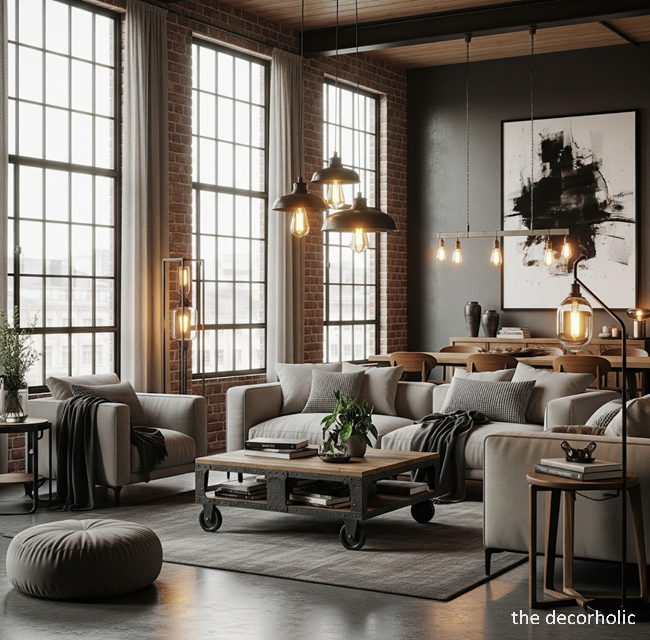
Modern industrial moody combines the raw, utilitarian aesthetic of converted warehouses and lofts with the sophisticated darkness of moody design. This style celebrates exposed structural elements, honest materials, and clean lines while embracing dark palettes that soften industrial’s sometimes harsh edge.
The beauty of industrial moody lies in the contrast between rough, unfinished elements (exposed brick, raw metal, concrete) and refined dark colors and plush textiles. This juxtaposition creates spaces that feel both edgy and comfortable, modern yet timeless.
Characteristics:
- Exposed brick walls (real or faux brick wallpaper in dark tones)
- Metal accents in raw steel, iron, or blackened finishes
- Leather furniture in dark brown or black with visible stitching
- Edison bulb lighting fixtures in metal cages or simple pendants
- Minimal ornamentation with focus on material honesty and clean lines
Key pieces: Black metal industrial shelving, leather Chesterfield or modern leather sofa in dark brown, industrial coffee table with metal base and wood top, vintage-style pendant lights with Edison bulbs, concrete or metal planters for greenery.
Traditional Moody
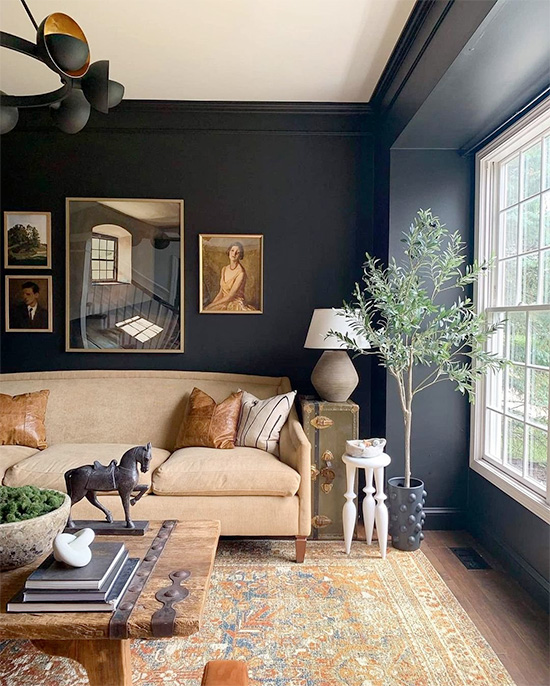
Traditional moody brings old-world elegance and classical sensibility to dark palettes, creating spaces that feel like sophisticated English manor libraries or French salon parlors. This style embraces ornate details, rich patterns, and layered complexity that make rooms feel collected over time rather than designed all at once.
The traditional moody approach works particularly well in older rentals with existing architectural details like crown molding, wainscoting, or traditional window frames. Dark colors highlight these features rather than hiding them, adding drama to historical elements.
Characteristics:
- Rich wood furniture in dark finishes (mahogany, walnut, espresso)
- Ornate gold or brass accents in picture frames, mirror frames, and hardware
- Layered patterns including damask, floral, paisley, and stripes in complementary colors
- Velvet and heavy fabrics on upholstery and window treatments
- Traditional furniture silhouettes: wingback chairs, tufted sofas, carved wood details
Key pieces: Tufted velvet Chesterfield sofa or traditional camelback sofa, ornate gold-framed oversized mirror, Persian or Oriental rugs in deep colors, crystal chandelier or traditional table lamps with fabric shades, dark wood coffee table with carved details.
Bohemian Moody
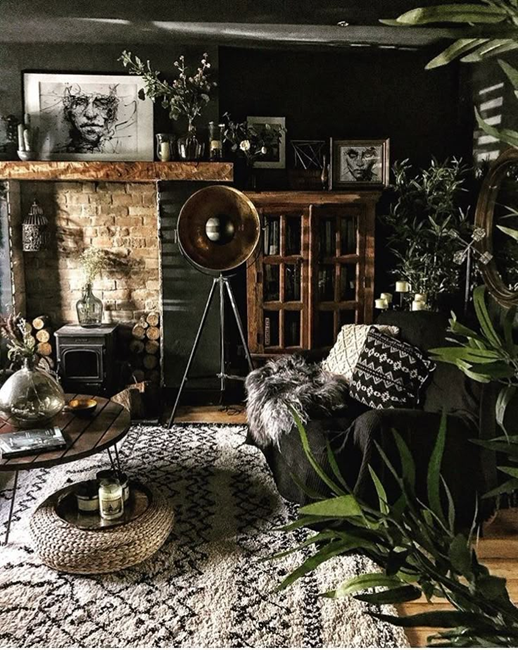
Bohemian moody blends global influences, eclectic collections, and free-spirited layering with dark, sophisticated color palettes. This style feels traveled and collected, incorporating textiles and objects from various cultures and periods while maintaining cohesion through consistent dark tones and rich textures.
The bohemian approach to moody design embraces maximalism—more pattern, more texture, more objects than minimalist or modern styles. However, the dark palette prevents this abundance from feeling chaotic, creating instead a curated, intimate atmosphere.
Characteristics:
- Global textiles and patterns from Moroccan, Turkish, Indian, and African traditions
- Eclectic mix of furniture styles and periods layered together
- Abundant plants in varied sizes and species throughout the space
- Woven textures including macramé wall hangings, rattan furniture, jute rugs
- Jewel-tone accents in emerald, sapphire, ruby, and amber
Key pieces: Low-profile sofa with ethnic-print pillows and throws, large macramé wall hanging, Moroccan pouf ottomans in leather or fabric, rattan pendant light or woven basket pendant, collection of potted plants in varied planters (ceramic, woven, terracotta).
Minimalist Moody
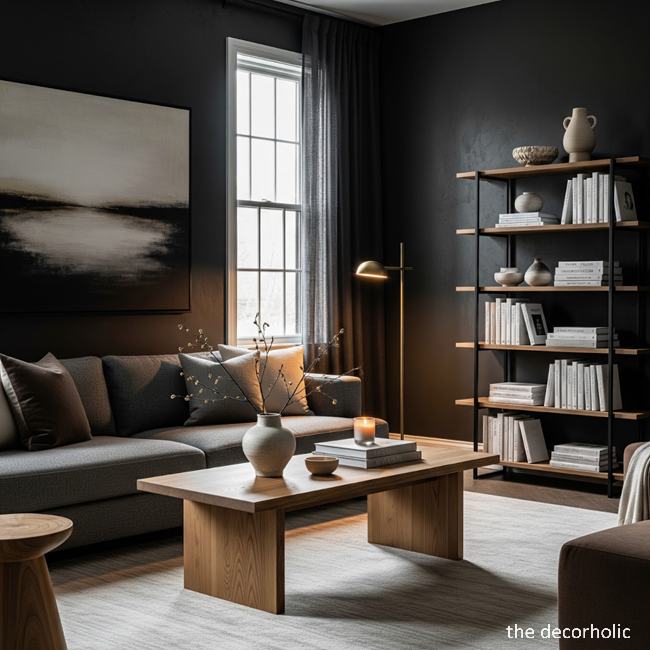
Minimalist moody proves that dark spaces don’t require abundance or ornate details to succeed. This style strips away excess, focusing on quality over quantity and negative space over filled surfaces. The result feels zen-like, calming, and intentionally spare while maintaining moody atmosphere through perfect color and lighting choices.
Minimalist moody is particularly well-suited to small rental living rooms where too many elements create visual chaos. By limiting furniture, decor, and pattern, you create spaces that feel larger and more serene despite dark colors.
Characteristics:
- Clean lines and streamlined furniture with no ornate details
- Monochromatic palette with subtle tonal variation rather than contrasting colors
- Abundant negative space with uncluttered surfaces
- High-quality materials chosen for longevity over trend (solid wood, quality upholstery, natural fibers)
- Sculptural lighting and furniture that functions as art
Key pieces: Low-profile sectional in charcoal or navy with minimal design details, sleek media console in dark wood or lacquered finish, single large-scale piece of abstract art, architectural floor lamp with interesting sculptural form, single dramatic statement plant (fiddle leaf fig or bird of paradise).
Expert Tip: Don’t try to combine more than two aesthetic styles in one moody living room. “Modern bohemian” or “traditional minimalist” can work beautifully when thoughtfully executed, but attempting to merge three or four styles creates visual chaos that undermines the sophisticated, curated feel essential to moody design. Choose your aesthetic lane and commit fully for best results.
Trending Post: Masculine Bedroom Ideas: Create a Stylish, Comfortable Sanctuary
Most Popular Post:
Interior Design Style Quiz
Timeless Paint Colors That Never Go Out of Style
Create Your Perfect Ergonomic Home Office: A Complete Guide
Must-Have Accessories for Guys: The Secret to a Stylish Space
Modular Sofas for Small Spaces: Brilliant Solutions for Compact Living
Conclusion: Your Moody Living Room Journey
Creating a sophisticated moody living room even if you rent is entirely achievable with strategic planning, renter-friendly solutions, and understanding of key design principles. The transformation doesn’t require professional help, unlimited budgets, or permanent changes—just thoughtful execution of dark colors, layered lighting, rich textures, and personal style.
Remember these essential takeaways as you begin your moody living room project:
- Start with one element: Choose removable wallpaper, a dark sofa, or dramatic curtains as your foundation
- Prioritize lighting: Three-layer lighting system with five-plus sources prevents dark spaces from feeling oppressive
- Layer textures: Velvet, leather, linen, wool, and natural fibers create depth that prevents flatness
- Scale appropriately: Larger furniture, oversized art, and substantial decor balance dark walls effectively
- Maintain consistently: Dark surfaces show dust and imperfections, requiring regular upkeep
Your moody living room should feel like a personal sanctuary—intimate, sophisticated, and uniquely yours. Take your time building the space gradually, living with changes before adding more elements, and trusting your instincts about what feels right. The most successful moody spaces evolve over months rather than materializing overnight.
Start small, commit to proper lighting, and embrace the dramatic transformation that dark colors bring to rental living. Your cozy, sophisticated moody retreat awaits.
Call to Action: Ready to begin your moody transformation? Start by choosing your dominant dark color and identifying your lighting needs. Document your starting point with photos, then tackle one element at a time. Share your moody living room progress and questions in the comments—we’d love to see your transformation!
Frequently Asked Questions (FAQ)
Q: Will a moody living room make my small apartment feel even smaller?
A: No—when executed properly with adequate lighting, moody colors can actually make small spaces feel more intimate and intentional rather than cramped. The key is implementing the three-layer lighting system and avoiding an all-dark approach by keeping trim or one wall lighter for contrast.
Q: How do I convince my landlord to let me paint walls dark colors?
A: Present your request professionally with paint samples, explain that you’ll return walls to original color upon move-out, and offer to use high-quality paint that covers easily. Many landlords approve when you demonstrate responsibility. If denied, focus on removable wallpaper, which requires no permission.
Q: What’s the best dark color for beginners nervous about going too dark?
A: Navy blue is the most approachable dark color because it reads as sophisticated rather than heavy, works with both warm and cool accent colors, and feels less dramatic than charcoal or black while still creating moody atmosphere.
Q: How much will it cost to create a moody living room on a tight budget?
A: You can achieve dramatic moody transformation for $500-800 by focusing on one wall of removable wallpaper ($150), three quality lamps ($120), curtains ($80), throw pillows ($90), and secondhand or repainted furniture. Start with high-impact elements and build gradually.
Q: Do moody living rooms work with pets and children?
A: Yes—dark colors actually hide pet hair, stains, and wear better than light colors. Choose durable fabrics like leather or performance velvet, avoid light-colored rugs, and maintain regular cleaning routines. The forgiving nature of dark colors makes moody rooms surprisingly practical for families.
Q: How do I prevent my moody living room from feeling like a cave?
A: Insufficient lighting causes the cave effect, not dark colors themselves. Implement at least five light sources at different heights, use warm white bulbs (2700K), position lamps in corners, and ensure task lighting near all seating areas. Proper lighting makes dark rooms feel cozy rather than oppressive.
Q: Can I mix different dark colors (navy, charcoal, burgundy) in one room?
A: Yes Install temporary command-strip shelves in dark wood or black metal to display curated objects
- Hidden organization: Ottomans with storage, dark baskets tucked under consoles, and decorative boxes maintain the streamlined look
Subscribe To the Newsletter!
Subscribe now for an endless feed of inspirational women’s cave decor ideas, pampering rituals, and more tips for curating your ultimate escape. Let’s start making your cozy refuge a reality – you so deserve this!
CATCH THE LATEST IN HOME DECOR TRENDS:
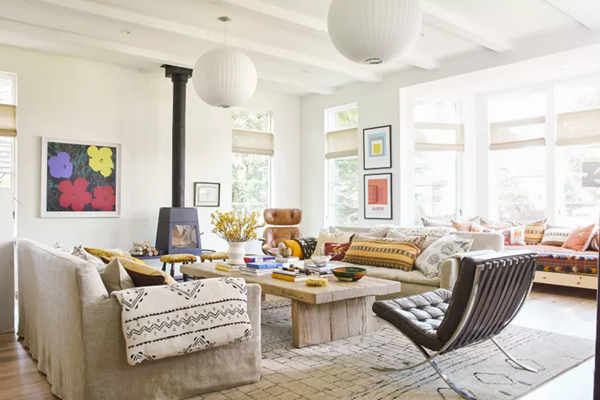
Steal These 16 Expert-Approved Decorating Secrets

How To Accessorize Your Living Room
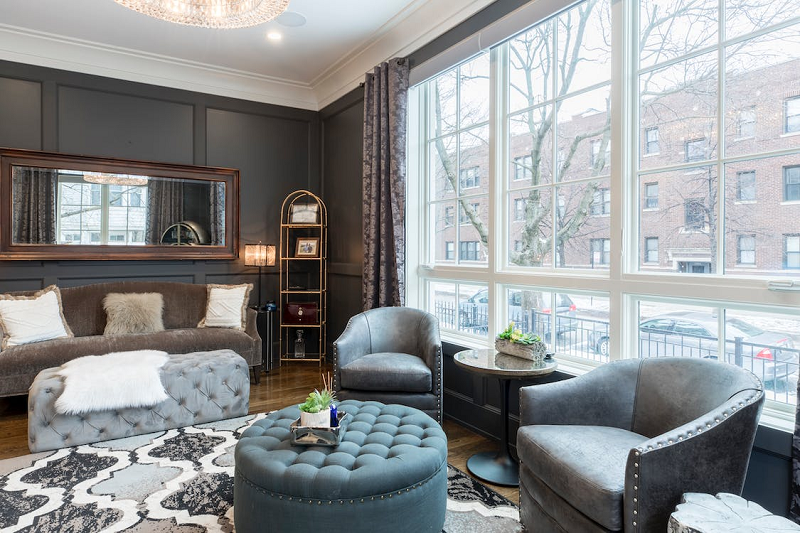
Small Space? 10 Ways To Make A Room Appear Bigger
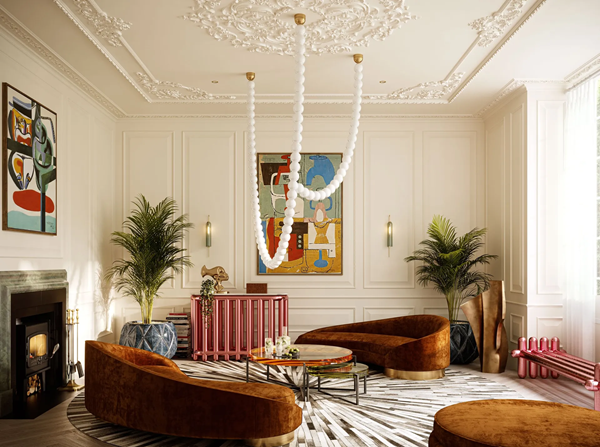
Make Your space Look Expensive
GET CAUGHT UP ON ALL THE INSPIRING DECOR TIPS:
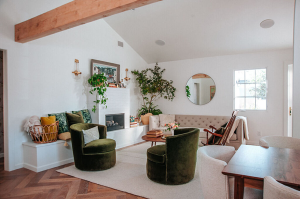
18 Fresh Decorating Ideas To Update Your Fireplace

How To Create An Art Gallery Wall


